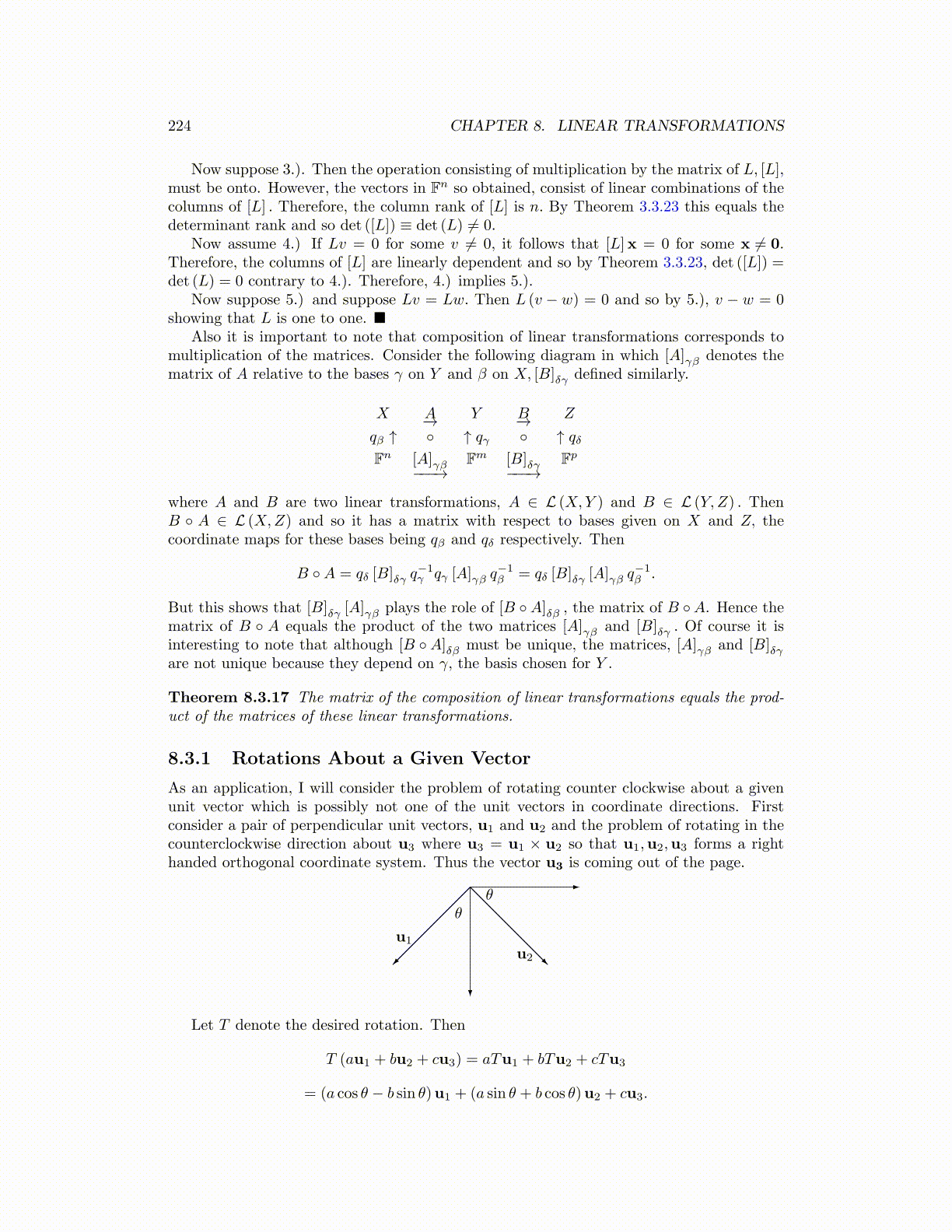
224 CHAPTER 8. LINEAR TRANSFORMATIONS
Now suppose 3.). Then the operation consisting of multiplication by the matrix of L, [L],must be onto. However, the vectors in Fn so obtained, consist of linear combinations of thecolumns of [L] . Therefore, the column rank of [L] is n. By Theorem 3.3.23 this equals thedeterminant rank and so det ([L]) ≡ det (L) ̸= 0.
Now assume 4.) If Lv = 0 for some v ̸= 0, it follows that [L]x = 0 for some x ̸= 0.Therefore, the columns of [L] are linearly dependent and so by Theorem 3.3.23, det ([L]) =det (L) = 0 contrary to 4.). Therefore, 4.) implies 5.).
Now suppose 5.) and suppose Lv = Lw. Then L (v − w) = 0 and so by 5.), v − w = 0showing that L is one to one. ■
Also it is important to note that composition of linear transformations corresponds tomultiplication of the matrices. Consider the following diagram in which [A]γβ denotes thematrix of A relative to the bases γ on Y and β on X, [B]δγ defined similarly.
X A−→ Y B−→ Z
qβ ↑ ◦ ↑ qγ ◦ ↑ qδFn [A]γβ−−−→
Fm [B]δγ−−−→Fp
where A and B are two linear transformations, A ∈ L (X,Y ) and B ∈ L (Y,Z) . ThenB ◦ A ∈ L (X,Z) and so it has a matrix with respect to bases given on X and Z, thecoordinate maps for these bases being qβ and qδ respectively. Then
B ◦A = qδ [B]δγ q−1γ qγ [A]γβ q
−1β = qδ [B]δγ [A]γβ q
−1β .
But this shows that [B]δγ [A]γβ plays the role of [B ◦A]δβ , the matrix of B ◦A. Hence thematrix of B ◦ A equals the product of the two matrices [A]γβ and [B]δγ . Of course it isinteresting to note that although [B ◦A]δβ must be unique, the matrices, [A]γβ and [B]δγare not unique because they depend on γ, the basis chosen for Y .
Theorem 8.3.17 The matrix of the composition of linear transformations equals the prod-uct of the matrices of these linear transformations.
8.3.1 Rotations About a Given Vector
As an application, I will consider the problem of rotating counter clockwise about a givenunit vector which is possibly not one of the unit vectors in coordinate directions. Firstconsider a pair of perpendicular unit vectors, u1 and u2 and the problem of rotating in thecounterclockwise direction about u3 where u3 = u1 × u2 so that u1,u2,u3 forms a righthanded orthogonal coordinate system. Thus the vector u3 is coming out of the page.
θθ
u1
u2
Let T denote the desired rotation. Then
T (au1 + bu2 + cu3) = aTu1 + bTu2 + cTu3
= (a cos θ − b sin θ)u1 + (a sin θ + b cos θ)u2 + cu3.